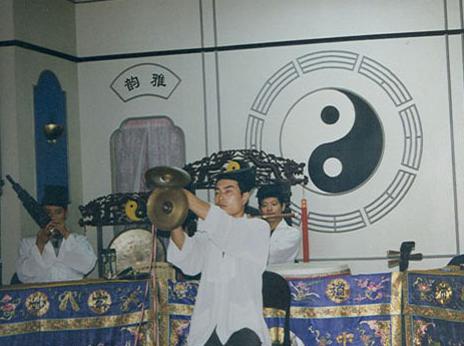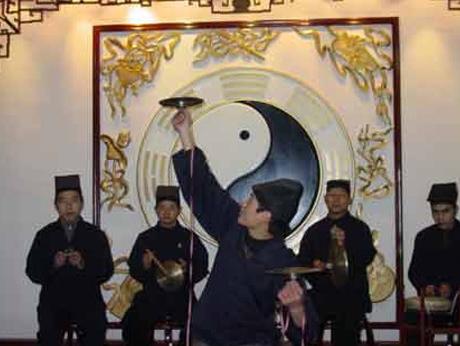
As the leading Taoist temples in Suzhou, Xuanmiao Taoist Temple is also the center for studying and performing Taoist music in Suzhou. Taoists inside the temple are known for belonging to the "Liberal Class" which is reputedly good at Taoist music. The artistic system of Taoist music has been fostered by two factors. On the one hand, it has benefited from imperial art of the Southern Tang Dynasty (with Jinling as its capital) and of the Southern Song Dynasty (with Lin'an as its capital). Hence it has gradually taken on the characteristics of imperial music. On the other hand, it has integrated dialects and folk music. Under the influence of Wu culture, it has made great progress in terms of both composition and performance. It boasts distinctive features of local music.
Belonging to Zhengyi School, Suzhou Taoist music can trace its history back to the Western Jin Dynasty. It has absorbed imperial and religious ceremonial music, as well as sacrificial ritual music. Meanwhile, it has also been influenced by Wu culture (culture in Yangtze River delta), specifically, Tangming (troupe) music, music in southern China played with traditional Chinese stringed and woodwind instruments, Kunqu opera, and Wu songs. As a result, a unique style has been cultivated, which is very popular among people. There are a great many related activities carried out.

Rooted in Wu culture, not only does Suzhou Taoist music share the common characteristics of Taoist music, but it also embraces distinct local flavors. Suzhou Taoist music comprises instrumental and vocal music. Instrumental music largely breaks down into flute music, drum beat, and combination of the two. It is played by someone who is either sitting still or moving about. The vocal music sings the Taoist scriptures. With rhythms, it is called "rhythmic tune" which takes on varied forms such as "praise", "eulogy", "sloka", "admonition", "paternoster", and "invocation".
As part of Chinese Taoist music, "flying cymbals" is a Taoist stunt with local characteristics of Suzhou. "Flying cymbals" is to Taoist music as performers to the music band. It is performed on the stage with accompaniment of Taoist music. A gesture of "flying cymbals" performers demands a certain type of music that the band has to play. So does the libretto of players. Hence perfect combination of sound and body movements, dynamic and static has been achieved in Taoist music which has been passed down for generations. For hundreds of years, "flying cymbals" has been well received in sacred places of Taoism including the Wudang Mountain in Hubei Province, Maoshan Mountain in Jiangsu Province, and Longhu Mountain in Jiangxi Province. The performance of "flying cymbals" comprises two sets of movements, one called "Upper Set" and the other "Lower Set". Every movement has a name. There are over twenty movements such as "lifting a flower basket", "tossing meteor-like objects", "rolling silk balls", "tower pyramid", and "single/double mascots to exorcize the malefic". It will take fifteen minutes to finish all the movements.

With a long history, Suzhou Taoist music is of high historic value. With a complete structure, sharp contrast, and rich expressiveness, it boasts substantial artistic value and exerts extensive influence on social life. With distinct characteristics of local music, it is different, in terms of style, from Taoist music in other places. It is very creative in various aspects, including flexible application of music to jiao (a Taoist sacrificial activity), unique solo of the bass drum, the guiding role the three-stringed instrument plays through its tendentious solo, and a piece of music played in four ways. All these are very impressive.





